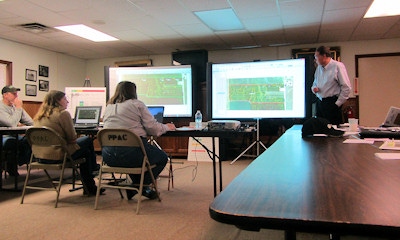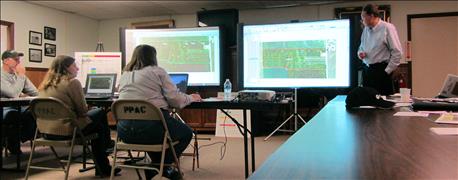
Suppose you could get aerial image of some fields on your farm during the growing season. From these images a crops consultant would decide where to pull stalk nitrate samples in very late summer to help you learn more about your nitrogen management program. After receiving the results, someone knowledgeable would set down and talk to you about it.
And that’s not all. You would be part of a group of 10 to 12 other farmers who were also participating in the program. And you would attend one half-day winter meeting with fellow participants and discuss overall results, findings and compare management strategies.

COMPARE AND LEARN: Hans Kok, standing, leads a discussion for a group meeting of INfield Advantage at the Pinney-Purdue farm near Wanatah.
What would you pay for this? $500? $1,000? $2,500? How about free? That’s right. INfield Advantage, operated by the Indiana State Department of Agriculture with the soil conservation partnership and support from commodity groups, offers this program free. The concept started as the On Farm Network in Iowa, and still operates there under the guidance of the Iowa Soybean Growers’ Association. In Indiana, it’s become the INfield Advantage program.
Meg Leader of ISDA is the coordinator. Here is information you should know about the basic level of the program. About 98% of those who participate are in the basic part of the program.
INFA focuses on regional groups of farmers
These groups can be anywhere from 10 to 20 growers, Leader says. Most local group leaders are soil and water conservation district staff members or ISDA field staff. You sign up through a local leader. Most growers sign up anywhere from two to six fields.
Guided Stalk Sampling is the basic level of the program
The vast majority of participants enroll fields in GSS, Leader says. If you enroll in GSS, you don’t need any special equipment. You also don’t have to make any changes in normal field management. You do fill out a basic field registration form that covers management and nutrient practices. You also supply field location information so that the imagery company collects images on the correct field. Yield data is not collected on these fields.
Advanced level of INFA
If you want to use tools to do on-farm research on a management question, you can enroll a field in the advanced level. It’s called replicated Strip Trial, Leader says. Only about 2% of fields in INfield Advantage are in RST.
What happens after registration in the basic program
Local leaders work with Leader to schedule aerial imagery. The goal is to collect it shortly after tasseling.
Then it’s up to the local group leader to organize work crews to go out after black layer and collect stalk samples. These are used by the participating lab to determine nitrate levels through the corn stalk nitrate test.
What information do you get back?
Individual GSS field reports are summarized and aggregated. Local data is collected into a regional report presented to each person at the winter meeting for that local group. The unique part of the program is the winter meeting, Leader says. The only people usually invited to attend are farmers who participated, the local leader and an agronomic consultant. Hans Kok currently is the primary facilitating agronomist at the meetings. Leader and Kok usually are the overall facilitators for the meeting.
What happens at these winter meetings?
Primarily, growers talk to each other about their own operations, and what worked and didn’t work, Leader says. Kok also introduces information about regional and statewide trends. But Leader insists that the purpose of the meeting is for farmers to talk to each other. “We want them to go home with more questions than they came with,” Leader says.
How can you enroll in the program?
Begin at the Website, Leader says. It is: INfieldadvantage.org. There is a contact form on the Website. Leader will personally see that your information gets to the group leader in your area. There is no charge to you.
Commodity groups cover costs through checkoff funds
Indiana Corn Marketing Council and Indiana Soybean Alliance checkoff funds cover the expense of imagery, lab work, report generation and an agronomic consultant. ISDA and SWCD staff members manage the program as a part of their overall job responsibilities in their positions.
Where are local groups currently located?
The map indicates where INfield Advantage groups are currently located. If there is no group indicated in your area on the map, it probably means no one has stepped up to be a group leader, Meg Leader says. “We won’t start a group without a group leader,” she says. Collection of stalk samples in the fall requires more time than some potential group leaders can commit.
Explanation of the map legend
Where SWCD staff led groups, some want to list their groups according to watersheds, especially if the leader is a watershed coordinator. That is their choice to list their group in that way. The group boundaries aren’t hard and fast, except for state borders, Leader says. If you’re in a group you can enroll a field which lies outside the area shown on the map.
Management groups refers to where all fields have common management. Reclaimed mine land is shown as INRM fields. Fields labeled INHM is a new group for 2016 sponsored by Indiana Pork. All fields will have manure applied.

About the Author(s)
You May Also Like




